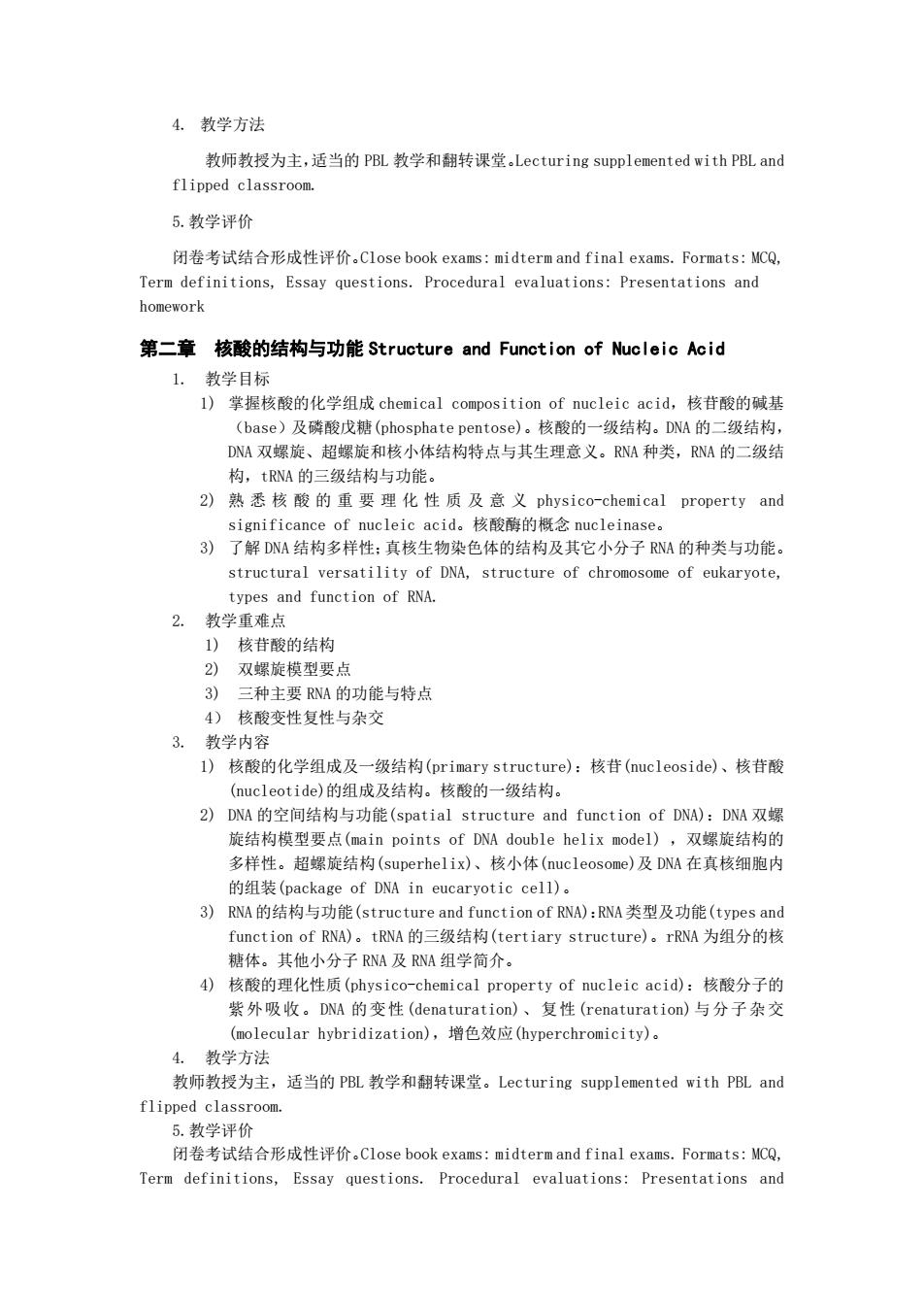正在加载图片...

4.教学方法 教师教授为主,适当的PBL教学和翻转课堂.Lecturing supplemented with PBL and flipped classroom. 5.教学评价 闭卷考试结合形成性评价.Close book exams:midterm and final exams..Formats:MCQ, Term definitions,Essay questions.Procedural evaluations:Presentations and homework 第二章核酸的结构与功能Structure and Function of Nucleic Acid 1.教学目标 l)掌握核酸的化学组成chemical composition of nucleic acid,核苷酸的碱基 (base)及磷酸戊糖(phosphate pentose)。核酸的一级结构。DNA的二级结构, DNA双螺旋、超螺旋和核小体结构特点与其生理意义。RNA种类,RNA的二级结 构,tRNA的三级结构与功能。 2)熟悉核酸的重要理化性质及意义physico-chemical property and significance of nucleic acid.。核酸酶的概念nucleinase.。 3)了解DNA结构多样性:真核生物染色体的结构及其它小分子RNA的种类与功能。 structural versatility of DNA,structure of chromosome of eukaryote, types and function of RNA. 2.教学重难点 1)核苷酸的结构 2)双螺旋模型要点 3)三种主要RNA的功能与特点 4)核酸变性复性与杂交 3.教学内容 1)核酸的化学组成及一级结构(primary structure):核苷(nucleoside)、核苷酸 (nucleotide)的组成及结构。核酸的一级结构。 2)DNA的空间结构与功能(spatial structure and function of DNA):DNA双螺 旋结构模型要点(main points of DNA double helix model),双螺旋结构的 多样性。超螺旋结构(superhelix)、核小体(nucleosome).及DNA在真核细胞内 的组装(package of DNA in eucaryotic cell)。 3)RNA的结构与功能(structure and function of RNA):RNA类型及功能(types and function of RNA)。tRNA的三级结构(tertiary structure)。rRNA为组分的核 糖体。其他小分子RNA及RNA组学简介。 4)核酸的理化性质(physico--chemical property of nucleic acid),:核酸分子的 紫外吸收。DNA的变性(denaturation)、复性(renaturation)与分子杂交 (molecular hybridization),,增色效应(hyperchromicity)。 4.教学方法 教师教授为主,适当的PBL教学和翻转课堂。Lecturing supplemented with PBL and flipped classroom. 5.教学评价 闭卷考试结合形成性评价.Close book exams:midterm and final exams..Formats:MCQ, Term definitions,Essay questions.Procedural evaluations:Presentations and4. 教学方法 教师教授为主,适当的 PBL 教学和翻转课堂。Lecturing supplemented with PBL and flipped classroom. 5.教学评价 闭卷考试结合形成性评价。Close book exams: midterm and final exams. Formats: MCQ, Term definitions, Essay questions. Procedural evaluations: Presentations and homework 第二章 核酸的结构与功能 Structure and Function of Nucleic Acid 1. 教学目标 1) 掌握核酸的化学组成 chemical composition of nucleic acid,核苷酸的碱基 (base)及磷酸戊糖(phosphate pentose)。核酸的一级结构。DNA 的二级结构, DNA 双螺旋、超螺旋和核小体结构特点与其生理意义。RNA 种类,RNA 的二级结 构,tRNA 的三级结构与功能。 2) 熟 悉 核 酸 的 重 要 理 化 性 质 及 意 义 physico-chemical property and significance of nucleic acid。核酸酶的概念 nucleinase。 3) 了解 DNA 结构多样性;真核生物染色体的结构及其它小分子 RNA 的种类与功能。 structural versatility of DNA, structure of chromosome of eukaryote, types and function of RNA. 2. 教学重难点 1) 核苷酸的结构 2) 双螺旋模型要点 3) 三种主要 RNA 的功能与特点 4) 核酸变性复性与杂交 3. 教学内容 1) 核酸的化学组成及一级结构(primary structure):核苷(nucleoside)、核苷酸 (nucleotide)的组成及结构。核酸的一级结构。 2) DNA 的空间结构与功能(spatial structure and function of DNA):DNA 双螺 旋结构模型要点(main points of DNA double helix model) ,双螺旋结构的 多样性。超螺旋结构(superhelix)、核小体(nucleosome)及 DNA 在真核细胞内 的组装(package of DNA in eucaryotic cell)。 3) RNA 的结构与功能(structure and function of RNA):RNA 类型及功能(types and function of RNA)。tRNA 的三级结构(tertiary structure)。rRNA 为组分的核 糖体。其他小分子 RNA 及 RNA 组学简介。 4) 核酸的理化性质(physico-chemical property of nucleic acid):核酸分子的 紫外吸收。DNA 的变性(denaturation)、复性(renaturation)与分子杂交 (molecular hybridization),增色效应(hyperchromicity)。 4. 教学方法 教师教授为主,适当的 PBL 教学和翻转课堂。Lecturing supplemented with PBL and flipped classroom. 5.教学评价 闭卷考试结合形成性评价。Close book exams: midterm and final exams. Formats: MCQ, Term definitions, Essay questions. Procedural evaluations: Presentations and